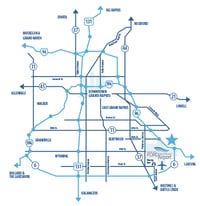Travel Tips
The best tips for business and leisure travelers, those flying alone or with a family, for a short trip or a long vacation.
Travel Tips
Packing Tips
Traveling with Kids
Traveling with Pets
Military Personnel
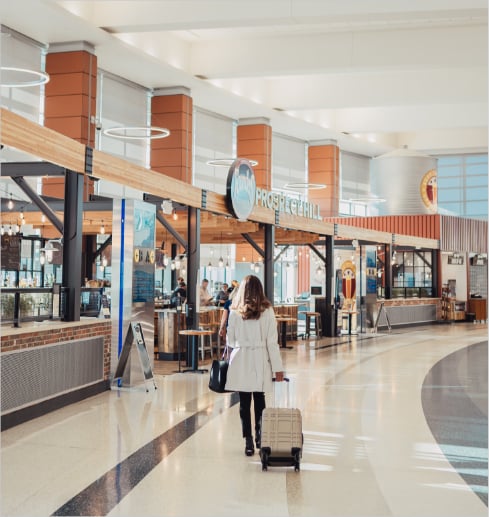
Make Air Travel Easy With These Tips
Traveling can be stressful, and navigating an airport at extremely late or early hours can make the process even more exhausting. To take the stress out of your trip, we’ve compiled these flying and airport tips for travelers of all kinds. Whether you’re flying for business or leisure, you’re by yourself or traveling with your family, you’re traveling with a pet, or you're meeting a loved one who is military personnel, we have tips for a smooth visit to GFIA.
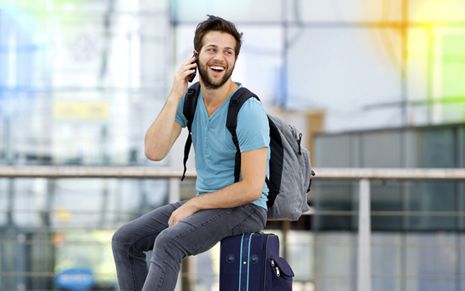
Wear sensible, comfortable clothing.
Call your airline's toll-free number or visit www.grr.org before leaving your home or office to find out if your flight is scheduled to depart on time.
Plan to arrive at the ticket counter no less than two hours prior to your scheduled departure. Airlines recommend being at the gate at least 45 minutes prior to departure. Additional time for parking and security should be considered as well.
Make a note on your parking stub as to where you parked your vehicle and take the stub with you. Upon your return, this reminder will help you in locating your vehicle.
Passengers 18 years of age or older should be prepared to present a photo ID at the ticket counter. If you do not have a photo ID, two other forms of ID will suffice, one of which must be government issued (e.g. social security card or voter registration). Do not leave luggage unattended at any time.
Take security seriously. Be prepared to place all items such as carry-on luggage, handbags, coats (including suit jackets and blazers), and shoes on the conveyor belt of the X-ray machine. Place miscellaneous pocket items in the separate basket provided. Also, be prepared to assist small children through the security checkpoint.
Be familiar with and abide by the TSA's 3-1-1 guidelines for all liquids and gels that you will take through security in your carry-on bags. Complete details are available at the TSA website.
Travelers with items such as cameras and film, computers, cell phones, and other electronic equipment may usually pass through the security screening equipment without harm to their belongings, but it's wise to inquire with the screening personnel if you have a concern.
Travelers with medical conditions, assistive devices, assistance animals, or other concerns should inquire with the screening personnel about alternative screening procedures that may be more appropriate. For more information visit the TSA website.
Remember that all carry-on luggage is subject to inspection at the security checkpoint. It could be required that items be opened or that packages be unwrapped for inspection. The TSA recommends leaving all gifts unwrapped until you reach your destination.
When on board the aircraft, use overhead bins wisely (heavier items should be placed on the floor beneath the seat in front of you), listen to the safety briefing, review the safety card, become familiar with all exits, and keep your seat belt fastened whenever you are in your seat.
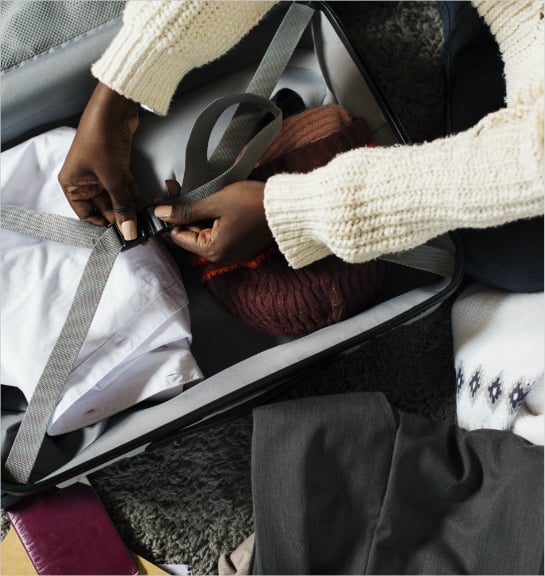
Packing Tips
When you are preparing for your trip, remember to pack smart and pack safe.
- Use luggage pieces that are lightweight, roomy, and durable. Material and design should be able to keep contents dry in adverse weather.
- Be sure that each piece has a secure lock. Remember: Using a TSA-approved lock ensures that your baggage can be checked by TSA baggage screeners without damage to your locks. TSA-approved locks are available for purchase at the gift shop in the main hall at GFIA.
- Know what's in your bags. Before you pack, check to be sure that there are no prohibited items that were left or stored in the bags since you last used them.
- Be sure to remove old destination tags from your luggage.
- Make sure all bags, both checked and carry-on, are identified with your name and phone number on the outside and inside.
- Don't overpack your luggage. Overpacking can cause baggage to rip apart or pop open during handling and transport.
- Pack fragile items in your carry-on.
- Place cell phones, electronic tablets, and personal gaming devices in your carry-on.
- Never pack film or video equipment in your checked baggage, as the baggage screening equipment can damage them. Cameras, film, and video equipment should be packed in your carry-on baggage.
- Put cosmetics, shoe polish, nail polish, liquor, perfume, and anything else that might spill, break, or stain into reclosable plastic bags or unbreakable containers.
- Placing undergarments and other clothing items in reclosable plastic bags allows TSA screeners to hand search your luggage (if necessary) while leaving your items clean and untouched.
- Remove hooks, straps, and removable wheels before checking luggage. They are easily caught in baggage handling machinery, which can cause extensive damage to your bag.
- Be aware that certain items and substances are restricted from checked or carry-on luggage. For a complete list of permitted and prohibited items in both carry-on and checked baggage, please visit the TSA website.
In the unlikely event that your checked baggage becomes lost or is misrouted, it is a good idea to pack essential items in a carry-on bag. Items include medications, change of clothes, personal care items, eyeglasses, and car keys. Also, items such as cameras, jewelry, money, passports, and other valuables should be packed in carry-on luggage.
Other than essentials, valuables, and fragile items, try to keep carry-on luggage to a minimum. Often, carry-on space inside an aircraft is at a premium. Remember that passengers are typically limited to two carry-on items, and these items must fit either under the seat or in the overhead bin. If you are traveling on a smaller aircraft, you may be asked to check your carry-on bag planeside.
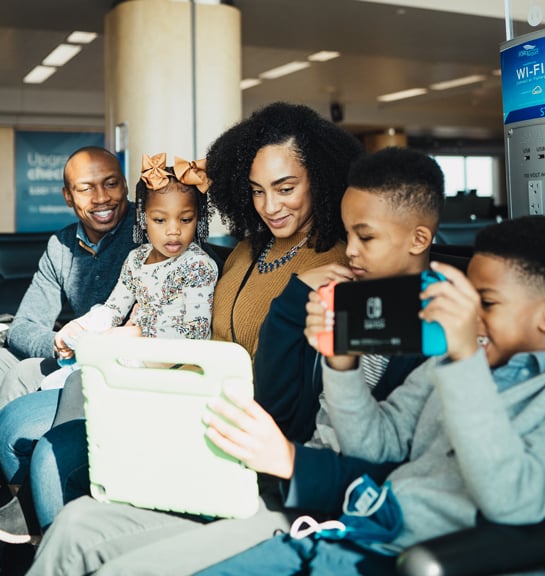
Tips for Traveling with Kids
Keep in mind your child's "best" and "worst" times of day when planning your departure. A flight at 6:30 in the morning may work well for you, but not so well for kids who tend to be cranky that early. Likewise, a late-night flight may find your kids either sleeping peacefully or wide awake.
When you're carrying luggage through crowded airports, make sure you have at least one free hand to hold onto a small child. If you're a parent, bring bags with shoulder straps and pack a backpack for your child.
Note:
Photo ID is required for all passengers age 18 and older. Children under age 18 are not required to have a photo ID.
- A backpack for every child old enough to carry one, packed with their favorite toys. Leave at home any toys with small parts, any toys that resemble weapons, or any toy that makes loud noises. Battery-operated DVD, CD, and game players with headphones are allowed on aircraft.
- Plenty of snacks and juiceboxes (3 oz. or less), however, avoid snacks that melt, crumble, stick, stain, or are spillable.
- Pre-moistened towelettes; lots of resealable plastic bags (for wet diapers and miscellaneous messy things); an extra t-shirt in case of spills on the plane.
Don't forget your child's safety when flying. The FAA recommends that a child weighing:
- under 20 pounds be placed in a rear-facing child restraint system.
- from 20 to 40 pounds use a forward-facing child restraint. Although the safety technology of forward-facing child restraint systems in aircraft is still developing, current restraints offer dramatic improvements in protection compared to lap-held or unrestrained children.
- over 40 pounds may safely use an aircraft seat belt.
For complete information and guidelines on the use of a child restraint system (CRS), please visit the FAA website.
When scheduling a day's activities with an infant, try to stick to your baby's normal schedule for naps, feedings, and alert times. And if you're flying cross-country, keep in mind the time difference.
As a precaution against ear problems during takeoff, time your infant's feeding with boarding the airplane. If your baby won't nurse or take a bottle, it might be a good idea to have a pacifier on hand.
When landing, begin to feed your baby liquid when you see the flight attendants checking passengers' seat belts in preparation for landing. The swallowing will help to equalize the pressure in the ears during descent.
What to bring
- Two or three changes of clothes for baby and one for yourself (the worst can happen). Plan ahead for changing weather conditions at your destination.
- Ready-made formula or powdered formula and bottled water for bottle-feeding babies.
- Three more diapers than you think you'll need. And resealable plastic bags for dirty diapers.
- Baby-wipes to clean up messes.
- If your baby is teething, bring teething rings, teething gel, or a pain medication approved by your pediatrician.
Each airline has its own guidelines about flying while pregnant. You should always contact your airline before purchasing your tickets to determine what its rules are for flying during your pregnancy. In general, it is recommended that you work with your doctor to determine whether or not it is safe for you to fly during your pregnancy. If he/she feels that it is safe for you to fly, request a letter stating this to show to the airline.
Remember, drugs normally taken for motion sickness may not be appropriate for a pregnant woman to take. NEVER take any medication while you are pregnant without consulting your doctor first!
You may want to bring some clear pop or ginger ale and bland crackers with you to help ward off nausea during the flight.
Flying on his or her own can be an exciting experience for a child, and a nerve-wracking one for a parent. Here are some tips to help ease your anxiety.
- Before the flight, talk to your child about what to expect of their travels. Review commonsense rules about not talking to strangers, but remind your child that if they need help to ask someone in a uniform, such as a police officer or flight attendant.
- Arrive at the airport early so that you'll have time to fill out the necessary paperwork before your child departs. The airline will ask you to supply some important information, including your contact information and the name of the individual who will be picking up your child at the final destination.
- Make sure your child knows to stay on board the plane after the flight until a flight attendant takes him or her to the customer service representative. This person will then see that your child is released to the individual that you have indicated. Be sure to let the individual picking up your child know that they must present a photo ID to airport personnel before leaving with the child, even if it is obvious that it is someone the child recognizes.
It's natural for you to worry about your child traveling alone. Just remember that your child is never really alone; the airline will assign someone to watch over him or her. Also, remember that airline rules vary, but age restrictions often apply to small children. Here are some general guidelines:
Children ages 1-4 may fly only when accompanied by a caretaker who is at least 12 years old. A child must be at least 5 years old to fly alone.
Children 5-8 years old may take a direct flight to a single destination, but not connecting flights.
Children over 8 may take connecting flights. If they're 8 to 11, they will be escorted by airline personnel to their connecting flight. A significant extra service charge for this is likely. Older kids -- ages 12 through 15 -- may request assistance, but are not required to do so. Please note that these are general guidelines. Some airlines may have more strict requirements. You should contact your specific airline if you have any questions.
Anyone under age 17 who is flying alone on an international flight must have a signed note from a parent or responsible adult giving permission, destination, and length of stay.
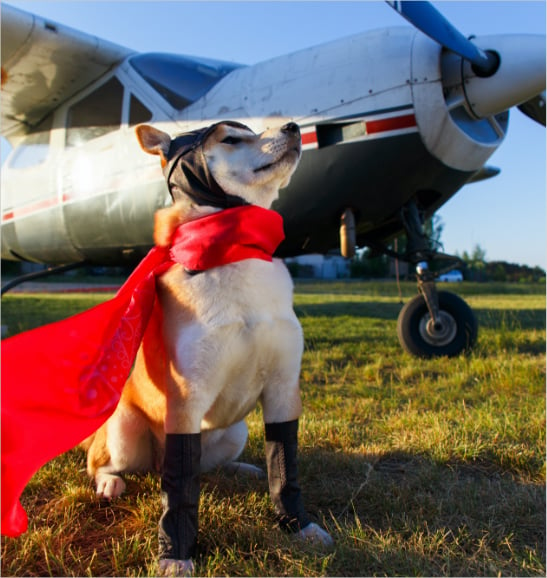
Traveling with Pets
Please be aware that all animals must remain in travel carriers at all times when in the passenger terminal building. This restriction does not apply to registered or certified service animals. There is a pet relief area outside on the west end of the terminal building where we suggest owners take their animals before departing. Animals that are not flying and are non-service animals are NOT allowed inside the airport terminal building. Violators will be asked to leave.
Please do not leave your pets unattended in vehicles. Pets can quickly suffer and die when left inside parked cars in extreme heat and cold, even for a short amount of time. For their safety, we advise leaving your furry friends at home, if you are picking someone up at the Airport.
It is important to note that this information does NOT apply to assistance animals. For specific information regarding the use of assistance animals on any flight, please contact your airline.
Over two million pets and other live animals are transported by air every year in the United States. Federal and state governments impose restrictions on transporting live animals. In addition, each airline establishes its own policy for the proper handling of the animals they transport. As a shipper or owner, you also have a responsibility to take the necessary precautions to ensure the well-being of the animal you ship.
The Animal and Plant Health Inspection Service of the U.S. Department of Agriculture enforces the Federal Animal Welfare Act. Here are several of the more important requirements.
- Dogs and cats must be at least eight weeks old and must have been weaned for at least five days.
- Cages and other shipping containers must meet the minimum standard for size, ventilation, strength, sanitation, and design for safe handling. (Sky kennels available for purchase from the airlines meet these requirements.)
- Dogs and cats must not be brought to the airline for shipping more than four hours before departure. (Six hours is permitted if shipping arrangements are made in advance.)
- If puppies or kittens less than 16 weeks of age are in transit more than 12 hours, food and water must be provided. Older animals must have food at least every 24 hours and water at least every 12 hours. Written instructions for food and water must accompany all animals shipped regardless of the scheduled time in transit.
- Animals may not be exposed to temperatures less than 45°F unless they are accompanied by a certificate signed by a veterinarian stating that they are acclimated to lower temperatures.
- Animals cannot be shipped COD unless the shipper guarantees the return freight should the animals be refused at destination.
Because each airline establishes its own policy, it is important to check with the air carrier you intend to use. However, the following are some provisions you will likely encounter at most airlines.
- Airlines generally require health certificates from all shippers. So it's a good idea to have a licensed veterinarian examine animals within ten days prior to shipment and issue a certificate stating that the animal is in good health.
- A pet may be transported as baggage if accompanied on the same flight to the same destination. Some air carriers may impose a special fee or "excess baggage" charge for this service. Pets may be shipped as cargo if unaccompanied, and many airline cargo departments employ specialists in the movement of animals. Animals must always be shipped in pressurized holds. Some airlines allow the kennel to be carried in the passenger cabin as carry-on luggage if it fits under the seat.
In addition to compliance with federal regulations and airline company policy, there are a number of precautions the owner/shipper can take to ensure the welfare of a shipped pet.
- Before traveling, acclimate your pet to the kennel in which it will be shipped. Make sure that the door latches securely.
- Do not give your pet solid food in the six hours prior to the flight, although a moderate amount of water and a walk before and after the flight are advised.
- Do not administer sedation to your pet without the approval of a veterinarian and provide a test dose before the trip to gauge how the pet will react.
- Be sure to reserve a space for your pet in advance and inquire about time and location for drop-off and pick-up.
- Try to schedule a nonstop flight; avoid connections and the heavy traffic of a holiday or weekend flight.
- When you board, try to tell a pilot and a flight attendant that there is a pet in the cargo hold. The airlines have a system for providing such notification, but it doesn't hurt to mention it yourself.
- For overseas travel (including Hawaii), inquire about any special health requirements, such as quarantine.
- Write your name, address, and phone number on the kennel, and make sure your pet is wearing a tag with the same information. Consider purchasing a temporary tag showing your destination address and phone number. Bring a photo of your pet, in case it is lost.
With careful planning, your pet will arrive safely at its destination.
Reports of animal mistreatment by airline personnel should be directed to:
U.S. Department of Agriculture
Animal Care Staff, APHIS-REAC-AC
4700 River Road
Riverdale, MD 20737
301-734-7833
This information provided by:
Aviation Consumer Protection Division
U.S. Department of Transportation
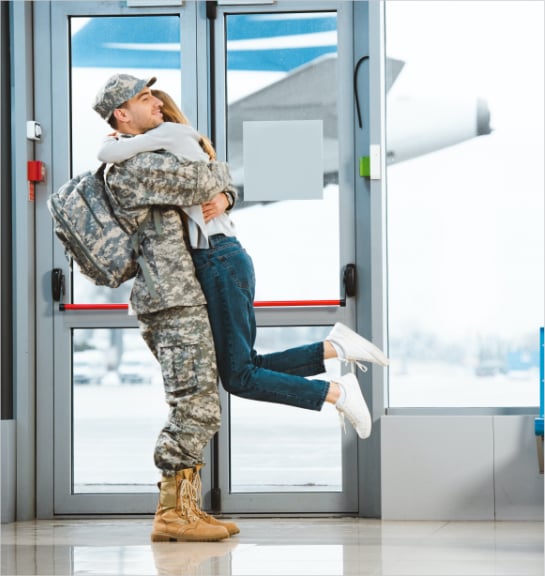
Military Personnel
The Military Welcome Center is open to military members, veterans, and their families 24 hours a day. The center offers charging stations, an airport arrival/departure monitor, and lounging space, as well as veteran profiles and programming offered by WGVU and PBS. There are also interactive maps and murals where military personnel and veterans can pinpoint where they have been stationed or deployed.
The Military Welcome Center is provided through a partnership with SpartanNash and GFIA. SpartanNash is the leading distributor of grocery products to U.S. military commissaries and a grocery retailer and food distributor headquartered in West Michigan for more than 100 years.
At GFIA, we understand that it is a difficult and emotional time for military personnel and their families when you have to say farewell. That is why we have included this page on our site. We want to provide you with as much information as possible so that your time at the airport is spent cherishing your time together, not worrying about what will happen here.
Immediate family members are welcome to accompany you through security screening to the gate area to await the departure of your flight. In order for this to occur smoothly, please have the following items when you arrive at the airport:
- Your military orders
- Photo ID for each family member over the age of 18
When you arrive at the ticket counter, please ask the ticket agent for a gate pass for each of your immediate family members who will accompany you to the gate area (this includes young children). The gate pass(es) will grant them permission to pass through the TSA security screening and into the sterile area of the terminal.
At the concourse entrance, each individual over 18 years of age will need to show his/her gate pass and photo ID. (Children under age 18 need only to have a gate pass.) Everyone will have to go through the security screening process so family members will want to dress accordingly. Your family is then welcome to wait with you at the gate area for your plane to board.
Coming home -- for a short furlough or at the end of a tour -- is an exciting time for you and your family. If they would like, immediate family members may greet you at the gate. In order for them to meet you in the sterile area of the terminal, they should:
- Arrive at the airport at least 45 minutes prior to your scheduled arrival
- Bring a photo ID for each family member over the age of 18
- Go to the ticket counter upon arrival at the airport and request a gate pass for each immediate family member. They will need to let the ticket agent know what flight you are arriving on.
The gate pass(es) will grant them permission to pass through the TSA security screening and into the sterile area of the terminal. Each family member will have to go through the standard screening procedure so they will want to dress accordingly.
Of course, all family and friends are welcome to greet you in the main hall of the passenger terminal building. And may we be the first to say..."Welcome Home!"



